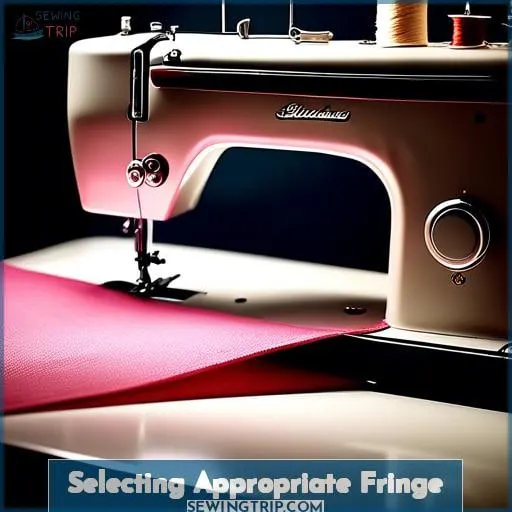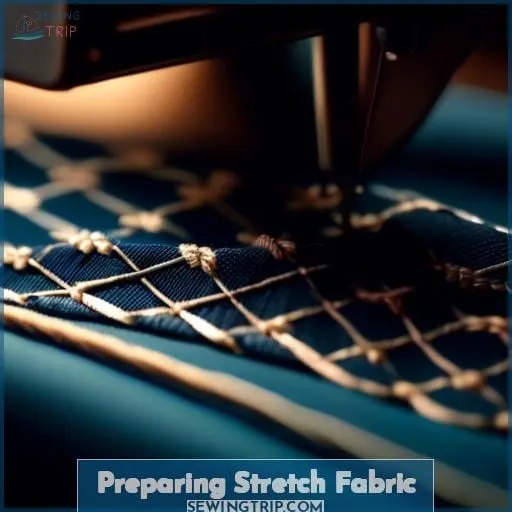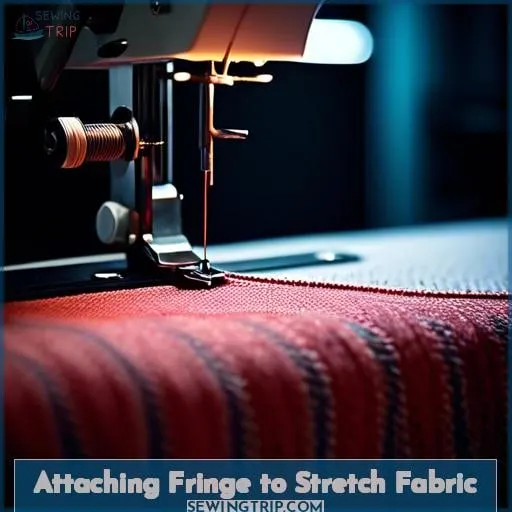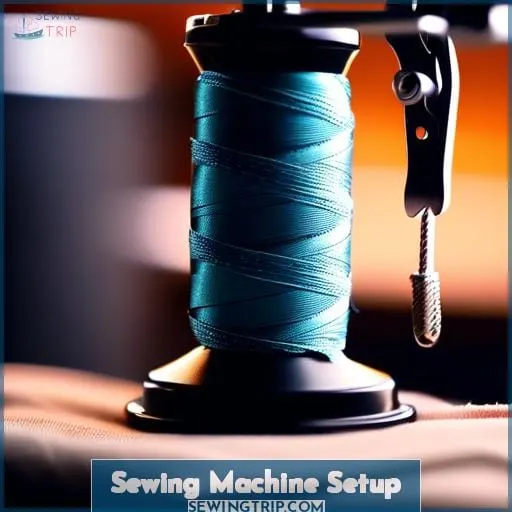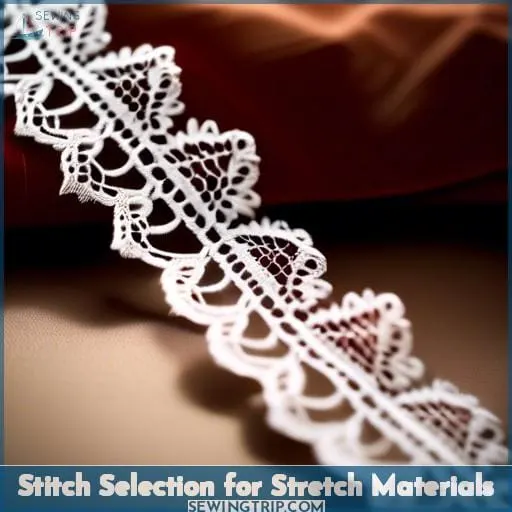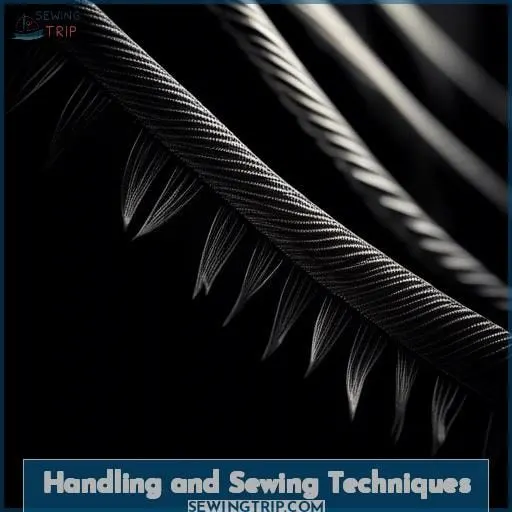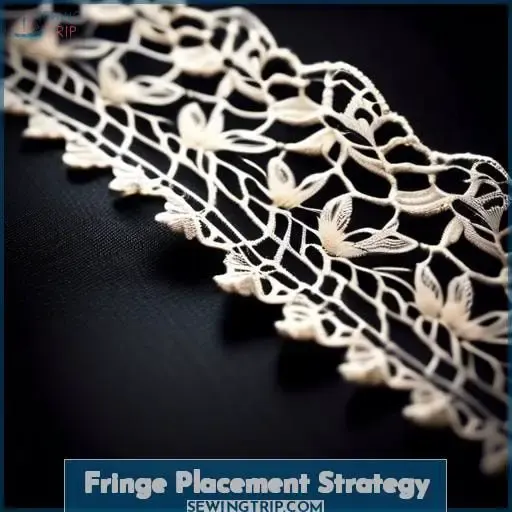This site is supported by our readers. We may earn a commission, at no cost to you, if you purchase through links.
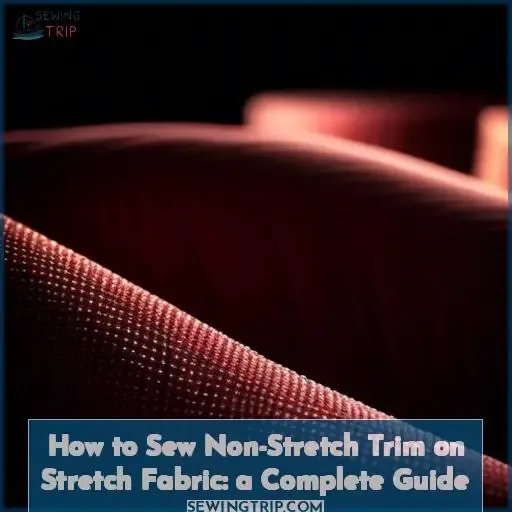 Embarking on the challenge of attaching non-stretch trim to stretch fabric requires precision and creativity.
Embarking on the challenge of attaching non-stretch trim to stretch fabric requires precision and creativity.
You’ll need to balance the fabric’s flexibility with the rigidity of the trim, ensuring your garment maintains its shape and comfort.
This guide will walk you through selecting the right materials, preparing your fabric, and executing the sewing process to achieve a professional finish without compromising the stretch.
Let’s dive into the techniques that will make your sewing project a success.
Table Of Contents
- Key Takeaways
- How to Sew Non Stretch Trim to Stretch Fabric
- Selecting Appropriate Fringe
- Preparing Stretch Fabric
- Attaching Fringe to Stretch Fabric
- Sewing Machine Setup
- Stitch Selection for Stretch Materials
- Handling and Sewing Techniques
- Fringe Placement Strategy
- Finishing and Troubleshooting
- Frequently Asked Questions (FAQs)
- Conclusion
Key Takeaways
- When attaching non-stretch fringe to stretch fabric, segment the fringe to maintain the fabric’s flexibility and avoid stiffness in the final product.
- To prevent distortion of the stretch fabric while sewing, avoid pulling the material and use a zigzag stitch to allow for seam elasticity.
- Proper sewing machine setup is crucial, including adjusting the presser foot pressure, selecting the right needle size and type, and using a walking foot to manage fabric movement.
- Finishing techniques such as using bias tape or double-sided tape on seams and steaming stretched seams can help restore the fabric’s size and shape, ensuring a polished end result.
How to Sew Non Stretch Trim to Stretch Fabric
To sew non-stretch trim to stretch fabric, cut the trim on the bias to add slight stretch, pin it carefully while slightly stretching the fabric, and sew using a stitch that accommodates stretch, such as a zig-zag or stretch stitch.
It’s important to use the right needle and tension settings to maintain fabric movement.
Selecting Appropriate Fringe
When choosing fringe for your project, it’s crucial to consider the stretch.
Stretch versus non-stretch fringe and chainette fringe specifics can significantly impact your final piece.
Stretch Vs Non-Stretch Fringe
When you’re diving into the project of sewing fringe onto stretch fabric, the choice between stretch and non-stretch fringe isn’t just about aesthetics; it’s about ensuring your creation has both durability and versatility.
Opting for stretch fringe means you’re embracing the fabric’s natural give, making your garment as comfortable as it’s captivating. However, if non-stretch trim catches your eye, fear not! With a bit of creativity, like segmenting the fringe, you can still achieve a dynamic look without sacrificing the stretchy fabric’s inherent charm.
Chainette Fringe Considerations
When diving into the world of adding pizzazz to your stretch fabric projects, chainette fringe is your go-to. Think of it as the cherry on top; its texture, color, and flow can transform the mundane into the magnificent.
But, here’s the kicker: choosing the right fringe color, density, and length is crucial. Opt for a fringe material that complements your fabric, and don’t forget to adjust those sewing settings! A stretch stitch is your best friend here, ensuring your non-stretch trim and stretch fabric live in harmony.
Preparing Stretch Fabric
Before you start sewing, it’s crucial to stabilize your stretch fabric to prevent it from warping.
Carefully marking and pinning the fabric ensures accurate alignment and a smooth sewing process.
Stabilizing Techniques
After diving into the fringe selection pool, let’s wade into the stabilizing techniques shall we? Think of your stretch fabric as a lively dance partner—it needs a bit of guidance to perform its best.
Enter fabric adhesives and bias tape application, your backstage crew ensuring every move is smooth. Tissue paper stabilization acts like a secret whisper, keeping the fabric from chatting too much under the needle.
Double-sided tape? That’s your quick-fix buddy. Adjusting presser foot pressure and choosing the right stitch patterns are like setting the rhythm for sewing fringe.
Marking and Pinning
After stabilizing your stretch fabric, it’s time to dive into marking and pinning, crucial steps for ensuring your fringe aligns just right.
For marking techniques, opt for tools that won’t snag or distort your fabric. Chalk wheels or disappearing ink pens are your best friends here, offering precision without the mess.
Moving on to pinning strategies, think of pins as your fabric’s temporary guardians. Pin perpendicular to the edge, ensuring stretch stabilization and fabric preparation are in harmony.
Attaching Fringe to Stretch Fabric
When attaching non-stretch fringe to stretch fabric, it’s crucial to consider flexibility.
Segmenting the fringe into smaller sections can provide the necessary stretch while maintaining the design’s integrity.
Sewing Non-Stretch Fringe
After stabilizing your stretch fabric, you’re ready to tackle the fringe challenge.
- Avoid fabric distortion by not pulling the material; let the feed dogs do their job.
- Maintain seam elasticity by using a zigzag stitch, which allows the fringe to move with the fabric.
- Space out non-stretch fringe to prevent a stiff look; think breathing room for your garment.
- Embrace chainette fringe for its versatility; it’s like the Swiss Army knife of the fringe world.
Segmenting Fringe for Flexibility
After tackling the challenge of sewing non-stretch fringe, let’s dive into segmenting fringe for added flexibility.
Think of it as giving your fringe a yoga class; by cutting it into smaller sections, you’re essentially teaching it to stretch. This clever trimming trick allows for movement and comfort, especially around areas that demand high mobility.
When attaching these segmented pieces, ensure they’re spaced evenly. It’s like giving your fabric room to breathe while maintaining that dazzling fringe effect.
So, grab your scissors and let’s start segmenting—your dance moves will thank you!
Sewing Machine Setup
When sewing non-stretch trim to stretch fabric, it’s crucial to set up your sewing machine correctly.
Adjust the presser foot pressure and select the appropriate needle to prevent fabric distortion and skipped stitches.
Presser Foot Adjustments
Adjusting your presser foot is like finding the perfect dance partner for your sewing machine; it’s all about harmony and balance.
When sewing non-stretch trim on stretch fabric, tension control becomes your rhythm, ensuring stitches neither strangle the fabric nor play too loose.
Fabric feeding is your dance floor, where a walking foot can glide your material smoothly without any missteps.
Needle size and thread type are your music, setting the pace for a flawless performance.
And don’t forget, seam allowances are the choreography, guiding your project to a show-stopping finale.
Choosing the Right Needle
Choosing the right needle is like picking the perfect dance partner for a tango with your stretch fabric.
Go for a needle with a ballpoint tip; it’s gentle and won’t snag your fabric’s threads.
Think of needle sharpness as the rhythm – not too sharp to pierce, but just right to glide.
And don’t forget about needle lubrication; it ensures your sewing machine and fabric move together smoothly, avoiding any awkward missteps.
Let’s get that sewing machine humming!
Stitch Selection for Stretch Materials
When sewing non-stretch trim onto stretch fabric, choosing the right stitch is crucial.
Zigzag and stretch stitches, along with the triple straight stitch, offer flexibility and strength for these materials.
Zigzag and Stretch Stitches
Diving into the world of stretch fabrics, let’s talk zigzag and stretch stitches.
Think of the zigzag stitch as your fabric’s best buddy, allowing it to stretch without snapping threads.
For those super stretchy moments, the stretch stitch is your go-to, acting like an invisible safety net.
And don’t forget your walking foot—it’s like having an extra pair of hands, ensuring everything stays in place.
Triple Straight Stitch Usage
When sewing fringe onto stretch fabric, the triple straight stitch is your secret weapon. This stitch, with its back-and-forth motion, offers strength and a smidge of stretch, ensuring your fringe won’t restrict movement.
Before diving in, stabilize your spandex with tissue paper to prevent puckering. Choose a needle that’s up to the task—usually a stretch or ballpoint needle.
As for settings, keep the stitch length short to maintain fabric integrity. Remember, the right seam finishing can turn a good project into a showstopper.
Handling and Sewing Techniques
When sewing non-stretch trim onto stretch fabric, using a walking foot can help manage the fabric’s movement. This technique prevents distortion, ensuring the fabric lays flat and the trim aligns properly.
Using a Walking Foot
Dive into your sewing adventure with a walking foot, your trusty sidekick against fabric distortion. Think of it as the superhero cape for your presser foot, ensuring every stitch lands with precision.
Choosing the right needle is like selecting the perfect arrow for your quiver, crucial for piercing through the fabric’s heart without a hitch.
And when it comes to stitch selection, it’s your spellbook, offering magical solutions to keep stretch and non-stretch fabrics in harmonious alignment.
Avoiding Fabric Distortion
Continuing from the walking foot wonder, let’s tackle that pesky stretch fabric distortion.
You’re sewing along, and bam, your fabric’s waving like a flag in a breeze. To keep things shipshape, employ fabric stabilization techniques.
When you’re laying down that non-stretch fringe, it’s like a tightrope walk. Precision is your best pal.
And for non-stretch fringe placement, it’s all about finding that sweet spot—no puckering, no sagging, just smooth sailing.
Fringe Placement Strategy
When considering fringe placement on your garment, it’s crucial to decide between full coverage or a skirt flap approach.
Ensure that the fringe allows for full range of motion, especially if the garment is for dance or performance.
Full Coverage Vs Skirt Flap
When deciding between full coverage or a skirt flap for your fringe extravaganza, consider the dance of fringe density and length.
Full coverage screams drama but requires careful fringe spacing to maintain movement. Skirt flaps flirt with freedom, allowing for playful fringe overlap without compromising mobility.
Ensuring Mobility
After covering your shorts in a dazzling fringe, you’ll want to ensure your show-stopping number doesn’t turn into a no-go zone for movement.
Opt for splitting fringe into segments for areas that need to bend and snap, just like Elle Woods’ courtroom tactics.
For the skirt-flap, non-stretch fringe can take a bow at the bottom, where less flex is needed. And remember, mixing up multiple fringe rows can add depth without compromising your groove.
Choose your fringe type like you’re matchmaking – compatibility is key!
Finishing and Troubleshooting
Once you’ve attached your fringe, it’s crucial to finish your seams properly to ensure durability and comfort.
If your seams have stretched out during sewing, applying steam can help them return to their original size and shape.
Seam Finishing Tips
When finishing seams on stretch fabric adorned with non-stretch fringe, think outside the box.
Use bias tape for a clean edge that moves with you, not against you.
Double-sided tape can be a sneaky ally, holding everything in place temporarily.
Don’t overlook the humble helpers: tissue, wax, and packing paper. These can stabilize the fabric as you sew, preventing those dreaded wavy lines.
Correcting Stretched Seams
- Steam the devil out of it. Hover your iron over the seam and let the steam work its magic, shrinking it back to size.
- If steaming doesn’t cut it, reinforce with bias tape for added stability without compromising stretch.
- Revisit your seam allowance. Sometimes, a slight tweak is all it takes to go from saggy to snug. Keep at it, stitch wizard!
Frequently Asked Questions (FAQs)
Can I use fusible interfacing with fringe?
You can use fusible interfacing with fringe. However, be cautious with stretch fabrics. It’s better to use a lightweight knit tricot interfacing to maintain flexibility.
How does fabric weight affect fringe attachment?
Fabric weight impacts how fringe behaves on stretch fabric.
Heavier fringe may pull and distort lighter stretch materials.
Lighter fringe allows for better movement and less alteration to the fabric’s natural drape.
Are certain fringe colors more fade-resistant?
Darker fringe colors tend to hold their hue better over time, resisting the fade that lighter shades might show after a few washes.
It’s like dark jeans staying crisp longer than their lighter counterparts.
Is hand-sewing fringe a viable option?
Yes, hand-sewing fringe is like threading dreams into fabric—meticulous yet magical.
It’s a dance of needle and thread, perfect for adding that personal touch.
Ideal for those craving creativity and a hands-on approach.
How do I clean garments with fringe?
To clean fringed garments, gently tie or bundle the fringes before washing.
Post-wash, lightly steam to remove kinks, or smack against a tub side to detangle—no need for a magic wand!
Conclusion
Selecting the right fringe, preparing your fabric with care, and mastering the sewing process are key steps in attaching non-stretch trim to stretch fabric.
By stabilizing your material, choosing the appropriate stitch, and employing the right sewing techniques, you’ll ensure your garment retains its shape and comfort.
With these guidelines, you’re equipped to tackle this challenge, achieving a professional finish that combines flexibility with style.

